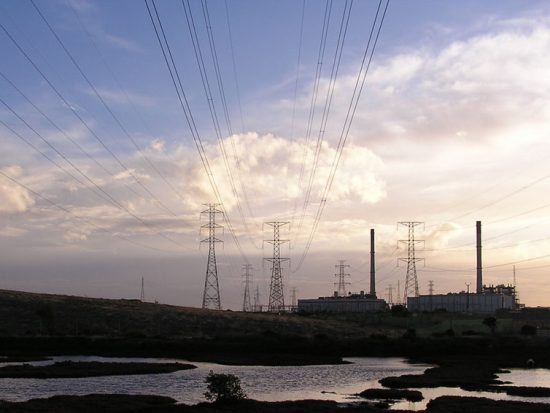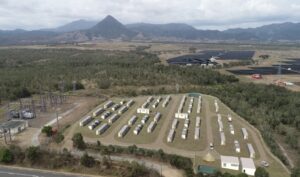AGL Energy is to mothball one of the four units at the Torrens B gas generator in South Australia, as traditional fossil fuel generators struggle in the face of the rapid transition to wind and solar and the switch from baseload generation to flexible capacity.
AGL said falling spot and forward wholesale electricity prices and the increase in the supply of electricity from new generators – meaning new wind and solar projects – is creating “challenging conditions” for the Torrens B generator.
The 200MW unit will be mothballed in October, and follows the previous announced mothballing and definitive closure of the older Torrens A gas generators. In their place will come AGL’s first big battery and the recently commissioned Barker Inlet fast start gas generators.
The announcement is significant because it is yet another sign of the transition from Australia’s traditional fossil fuel baseload grid to one based on renewables and flexible capacity, including fast-start gas but increasingly other forms of storage such as batteries and pumped hydro.
South Australia closed its last coal generator in 2016 and is now witnessing a progressive shut down and mothballing of its remaining “baseload” or “intermediate” gas fleet, as the share of wind and solar reaches 60 per cent of local demand and heads towards the state Liberal government’s target of “net 100 per cent” by 2030.
And contrary to the federal government’s stated view that more gas generation is needed in the transition to renewables, the Australian Energy Market Operator is predicting a rapid decline, particularly in South Australia as newly installed synchronous condensers come online in the next month or two.
Torrens B consists of four 200MW gas-fired generators which were commissioned in 1976, and the mothballing will coincide with its 46th year of operation, making it one of Australia’s oldest operating gas generators.
The Torrens B units are steam turbines, where gas is burned to produce steam for the turbines, and they do not have the same fast-start capabilities of newer gas turbine units, such as those at the neighbouring Barker Inlet power station that was commissioned by AGL in 2019.
AGL says the mothballing process at Torrens B means it could recall the unit back into operation, if needed, but it would need six months notice.
In March, AGL announced it would build a 250MW big battery at the Torrens power station site, marking another step in the company’s transition from its older fleet of fossil fuel generators to clean energy projects.
The first stage of the battery will feature one hour of storage, but AGL envisions it will be upgraded to four hours storage, or a total of 1,000MWh, as battery storage plays a bigger role time shifting renewables for when they are needed at times of peak demand.
It is also a further indication of the evolving dynamics within the Australian energy market, with lower cost supplies of wind and solar generation and the growing attractiveness of battery storage for its grid support services – and now arbitrage – pushing ageing fossil fuel assets out of the market.
This will be AGL’s first big battery, although it is also planning a 200MW big battery with four hours storage at its Loy Yang A brown coal generator in Victoria, a 150MW battery (possibly up to 500MW) at the soon to be closed Liddell coal generator in NSW and a 50MW big battery at Broken Hill.
AGL already contracts the output from the Dalrymple North battery in South Australia, but it does not own that facility.
It has a contract with, but does not own, a new 100MW/150MWh big battery at Wandoan South that is being built in Queensland, and has also commissioned Maoneng to build 200MW and 400MWh of battery storage in NSW.
Coincidentally, Maoneng has also quietly unveiled its own plans for a 225MW/450MWh big battery at Gould Creek, located at a substation just north of Adelaide.
See RenewEconomy’s Big Battery Storage Map of Australia
South Australia will soon see the deployment of new synchronous condensers across the state, which provide crucial system strength services to the electricity system – replacing the services traditionally provided by baseload fossil fuel generators, but without the need to burn fuels.
The installation of the four syncons will dramatically reduce the number of interventions and directions in the South Australia market, and the need for gas generation to provide system support.
AGL recently unveiled more details of its planned split of its business that would carve out the company’s fossil fuel assets into a separate unit, where it is expecting ongoing headwinds because of higher gas prices.
AGL’s chief operating officer, Markus Brokhof, said the company’s decision to mothball the unit at Torrens B had been based on an assessment of the long-term financial viability of the plant and AGL’s future plans to use the site as a location for the future big battery project.
“We will continue to provide South Australians with access to reliable and affordable electricity. We have assessed all publicly available information and are confident there is sufficient capacity available to AEMO to ensure system strength,” Brokhof said.
“Torrens Island continues to be an important site for our future generation plans, including its development as a low-carbon industrial energy hub of the future.”
“Construction of our 250MW grid-scale battery is planned to begin later this year, making it the first of AGL’s planned 850 MW of batteries to get underway.
“This new grid scale battery along with the Barker Inlet power station that commenced operations in 2019 demonstrates our commitment to playing a leadership role in the state’s energy transition,” Brokhof added.
AGL said that the decision to mothball the unit would not impact AGL’s 400-strong workforce in South Australia but added the ongoing future of both the Torrens B units and the Barker Inlet power station would be reviewed if there were any “material changes” conditions in the energy market.
The decision to begin the mothballing process at Torrens B comes as AGL prepares to decommission the Torrens A power station, which consists of four 120MW gas-fired generation units, scheduled for September 2022.
AGL has already mothballed three of the generating units at the Torrens A power station, with the fourth to be mothballed in September this year.









